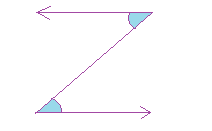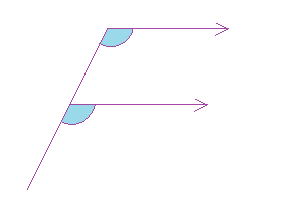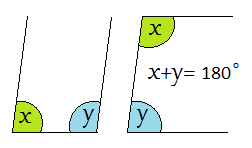
Angles and Parallel Lines
We are going to have a look at some angle relationships that are created when we have a pair of parallel lines (AB and CD) and a transversal (EF) that crosses them.

There are many angles in the above diagram. Lets review some pairs of angles that have special names.
| X-Rule: Vertically opposite angles are equal. |  |
| U or C-Rule: Cointerior angles of parallel lines are supplementary |  |
| Z-Rule: Alternate angles of parallel lines are equal |  |
| F-Rule: Corresponding angles of parallel lines are equal. |  |
Of course, these angle relationships won't look like X's, U's, Z's and F's in all diagrams because the diagram may be rotated and consist of more lines.
Vertically opposite angles are equal. (X rule).
Cointerior angles of parallel lines are supplementary. (U or C rule).
Alternate angles of parallel lines are equal. (Z rule).
Corresponding angles of parallel lines are equal. (F rule).
Worked Examples
Question 1
Find the value of $x$x
Question 2
Find the values of the pronumerals in the diagram shown,
a) Find the size of angle $u$u
b) Find the size of angle $v$v
Question 3
Calculate $x$x giving reasons for your answer.
Question 4
Calculate $x$x giving reasons for your answer.
Solving problems
When solving angle problems in geometry one of the most important components is the reasoning (or rules) you use to solve the problem. You will mostly be required in geometry problems to not only complete the mathematics associated with calculating angle or side lengths but also to state the reasons you have used. Read through each of these rules and see if you can describe why and draw a picture to represent it.
Angles in parallel lines
| Cointerior angles in parallel lines are supplementary (U, C)
|
 |
| Corresponding angles on parallel lines are equal (F)
|
 |
| Alternate angles on parallel lines are equal (Z)
|
 |
| Vertically opposite angles are equal (X)
|
 |
A summary of the geometrical properties of angles can be found here.
A summary of the geometrical properties of triangles can be found here.
A summary of the geometrical properties of quadrilaterals can be found here.